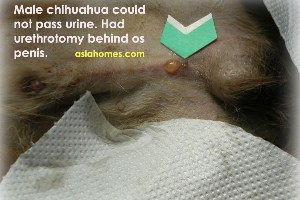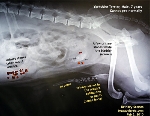URETHROSTOMY METHOD
The surgical approach to removing
the urinary stones in the dog or
cat depends on the vet. If the
urinary stones are stuck at the
urethra behind the os penis, the
logical approach will be to cut
open the urethra behind the penile
bone and remove the stones. The
male dog should then pee like a
female dog. He squats down and
pees. In practice, an old male dog
may not be able to change his
mindset. He has had been peeing
with one leg up, against a
vertical surface or he may have
been urine-marking all the time.
Now, a human being expects him to
pee like a female dog. This is
expecting too much even in people
who have had to change their
mindsets.
What if the male dog with
urethrostomy continues his old
way? He may have a sad ending as I
recall the following case. A Chihuahua
whose owner resided in
Toa Payoh in 2004 could not pass urine.
The urinary stones blocked his urethra
at the os penis (penile bone). His bladder was going to
rupture soon. I advised
 surgery to create an opening behind the os
penis so that he would be able to pass urine and
to survive. This surgery is called urethrostomy. surgery to create an opening behind the os
penis so that he would be able to pass urine and
to survive. This surgery is called urethrostomy.
The owner went to another vet after
getting a diagnosis from me. Such
situations happen to all vets and
so I was not offended.
The other
vet did a urethrostomy behind the
os penis as this is a standard
practice. There were no stones in
the bladder I presumed as the
owner did not want me to handle
the case.
The problem of being unable to pee
was resolved. However, the owner
brought the dog to me some weeks
later and said: "My Chihuahua
pees like a female dog. He
dribbles urine all over the
apartment after the surgery (see
photo above). I want him to be put
to sleep."
Vets do urethrostomy if the
bladder has no stones and stones
are found only in the urethra. It
is logical. But should the dog
continues urine-marking, the urine
just "leaks" everywhere as I
suspected in the above-mentioned
Chihuahua. In theory, male dogs
with urethrostomy should be able
to control their urination and pee
at approved places. The theory is fine
if you are not the Chihuahua or
the owner needing to clean up the
apartment hundreds of times a day.
In retrospect, it
is best to properly house-train
your puppy or neuter him when he
is young to
prevent urine-marking.
Urine-marking affects the
cleanliness of the apartment and
other family members may not be
too pleased about this anti-social
behaviour.
If there are no stones inside the
bladder, most vets will use the
urethrostomy method. It is
logical. However, in the above
case, a cystostomy would have
enabled this male Chihuahua to
live to the end of his life-span.
But how many vets would do a
cystostomy when stones are present
behind the os penis? I doubt there
are any. However, a cystostomy to
remove all stones may be best for
the male dog living inside an
apartment.
A cystostomy case with
urohydropropulsion is shared with
fellow vets below.
 CYSTOSTOMY METHOD CYSTOSTOMY METHOD
Yorkshire Terrier, Male, 9 years.
3.6 kg 39.4C
Urethral obstruction.
X-rays showed urinary stones in
the bladder and behind the os
penis.
What is the surgical approach?
|
30.1.2010 |
31.1.2010 |
Domitor 0.3ml IV
Isoflurane gas
Antisedan 0.3 ml IM at the
end of surgery
IV glucose 200 ml
pre-surgery
Hartman Solution IV 2 days
post op
Baytril 0.3 ml and Rimadyl
0.2 ml SC |
Ate l can A/D diet. T=38.7
deg C
To flush bladder again. Lots
of bleeding and debris.
Catheter in the bladder for
at least 3 days. Nursing
needed.
|
SURGERY on 30.1.2010
In this case, cystostomy was
performed, although some vets
do cystostomy and urethrostomy as
dictated by the presence of
numerous stones in the penile
urethra.
A catheter is used to
dislodge all stones via flushing
many times during the operation.
The catheter was inserted via the
penile urethra and the bladder to
dislodge and flushed all stones.
There was no need for urethrostomy although on first
impression from the X-ray, a
urethrostomy behind
the os penis would seem logical.
The dog was catherised for 3 days.
I presume most vets would perform
urethrostomy and cystostomy but it
is best for the dog just to do
cystotomy with urohydropropulsion.
4th Year Vet Students Studying Vet
Surgery: For more information
about the techniques of
urohydropropulsion, see one of the cases at:
Urinary Tract Problems |
 TOA
PAYOH VETS
TOA
PAYOH VETS TOA
PAYOH VETS
TOA
PAYOH VETS